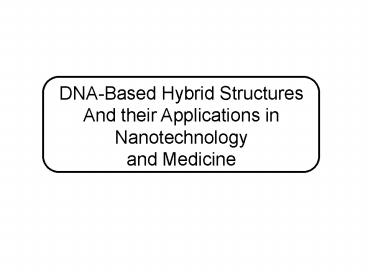DNABased Hybrid Structures - PowerPoint PPT Presentation
1 / 17
Title:
DNABased Hybrid Structures
Description:
DNA-Based Hybrid Structures. And their Applications in. Nanotechnology. and Medicine ... How to assemble nanoparticles into superstructures? Attach organic ... – PowerPoint PPT presentation
Number of Views:23
Avg rating:3.0/5.0
Title: DNABased Hybrid Structures
1
DNA-Based Hybrid Structures And their
Applications in Nanotechnology and Medicine
2
Why Gold?
RS(cov) RAu(cov) 1.05 1.36 2.41 Å
3
How to assemble nanoparticles into
superstructures?
Attach organic molecules capable of non-covalent
interactions. Ideally, those which are strong
and highly directional. First attempt
Hydrogen bonding
Au NPs covalently functionalized by DNA strands
were successfully synthesized by Mirkin et al.
in 1996. DNA hybridization-driven aggregation
of particles and changes in color were
observed. Drawback 1 Aggregation is random
and does not produce assemblies which are
well-defined in size or shape. Drawback 2
Aggregates have NO solution stability. They
precipitate as soon as they are formed.
A DNA-based method for rationally assembling
nanoparticles into macroscopic materials Mirkin
et al. Nature 1996. ISI citations 1680.
4
Sensing
5
Changes in optical properties induced by
aggregation of Au NPs
6
Colorimetric detection of DNA
7
AntiSense Drugs
8
Preparation of antisense DNA-functionalized gold
nanoparticles
9
Intracellular stability of antisense
DNA-functionalized nanoparticles
Science 2006, 312, 1027-1030
10
Fluorescent EGFP protein knockdown
control
Cells treated with ASNPs
11
Asymmetric Functionalization of Gold
Nanoparticles with DNA
JACS 2006, 128, 9286-9287
12
Influence of ligation on melting temperature
13
Directional assembly of asymmetrically
functionalized AuNPs
cat paw
satellite
14
Directional assembly of asymmetrically
functionalized AuNPs
Dendrimer-like structures
15
Bio-bar-code DNA detection with PCR-like
sensetivity
16
Amplified anthrax bar-code DNA detection
17
Nanoparticle-based bio-bar codes for the
ultrasensitive detection of proteins
Science 2003, 301, 1884-1886































